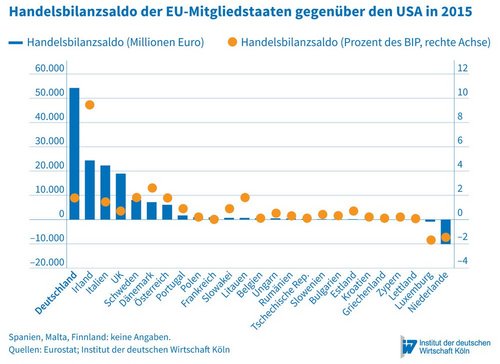The German export surplus is heavily criticized by the USA. The German economy ranks first among the EU Member States when measured in terms of the absolute trade surplus. But the picture changes when the economic size of the individual countries is taken into account. Other EU countries, especially Ireland, are also likely to suffer from a new American protectionism.

New American protectionism: Who is affected most?

The German export surplus is heavily criticized by the USA. The German economy ranks first among the EU Member States when measured in terms of the absolute trade surplus. But the picture changes when the economic size of the individual countries is taken into account. Other EU countries, especially Ireland, are also likely to suffer from a new American protectionism.
According to data for the year 2015, the European Union (EU) recorded a surplus of about 154 billion euros in the trade balance with the USA. It is true that exports of goods to the US exceed US imports from almost all EU Member States (Figure). Germany has the highest trade surplus in transatlantic trade, with the result that US President Trump is particularly threatening German export companies with protectionist measures such as customs duties. But other EU Member States would also be severely affected. The exports of goods from Ireland to the USA exceed the imports of goods from the USA by 24 billion euros. In Italy and the United Kingdom, the surplus of 22 billion euros and 19 billion euros is also considerable. Ireland, in particular, stands out with its high trade surplus, as it is almost half as high as the surplus of Germany, while the Irish economy is almost twelve times smaller than the German economy in terms of gross domestic product (GDP).
If the export surplus in trade with the USA is adjusted by the size of the EU Member States, Germany does by no means rank first. Germany's trade surplus makes up 1.8 per cent of GDP and is therefore roughly as high as that of Sweden, Austria and Lithuania. In Ireland, the surplus in trade with the US makes up more than 9.5 per cent of GDP and the surplus of Denmark (2.6 per cent) is also higher than the German one. These countries would be hit at least as hard as Germany by new protectionist measures, since the dependence of the economy on the export surplus with the US is also very strong.
But just as hard as its trading partners, the US economy itself and US citizens are likely to be affected by newly introduced protectionist measures. The production costs would rise significantly as 81 per cent of the German goods exports to the USA are attributable to capital and intermediate goods. It is hardly possible to replace these with cheaper domestic suppliers, because these are often highly specialised products. It will take years to substitute these products since the corresponding know-how in many cases is lacking and high investment in research and development is necessary. Thus, end users and industry in the US will have to bear the additional costs of higher trade barriers.
The above figures show how distorted the debate about Germany's trade surplus is. The fact that the German surplus in the trade with the USA is so strikingly high is due to the fact that Germany is the largest economy in the EU. If GDP is taken into account, Germany has by no means the highest trade surpluses with the USA among EU Member States. The debate about the export strength of Germany is not only based on trade balance data. Rather, the current account balance is used, which includes, in addition to trade in goods, the service trade as well as the balances of primary and secondary income. In the service trade with the USA, Germany recorded a comparatively small surplus of around 1.5 billion euros in 2015. By way of comparison, in 2015, the United Kingdom reported a surplus in the balance of payments balance with the USA of over 32 billion euros. The balance of primary income is with 6.1 billion euros also positive, which means that the current account surplus is somewhat higher than the trade surplus. However, protectionist measures such as tariffs and import restrictions would mainly affect trade in goods and leave the trade in services and income transfers unaffected.
More on the topic
Not so Different?: Dependency of the German and Italian Industry on China Intermediate Inputs
On average the German and Italian industry display a very similar intermediate input dependence on China, whether accounting for domestic inputs or not.
IW
China’s Trade Surplus – Implications for the World and for Europe
China’s merchandise trade surplus has reached an all-time high and is likely to rise further. A key driver appears to be a policy push to further bolster Chinese domestic manufacturing production, implying the danger of significant overcapacities.
IW